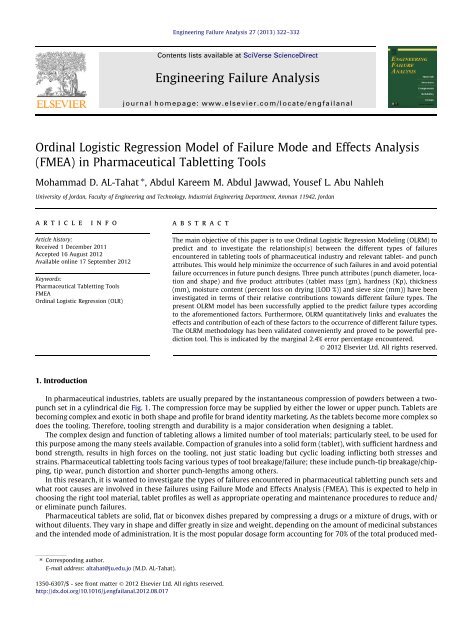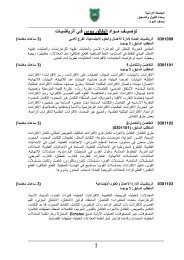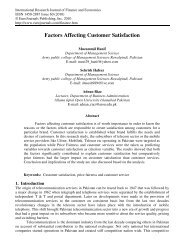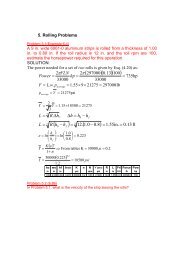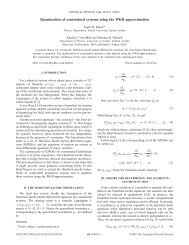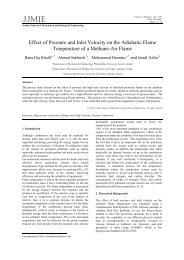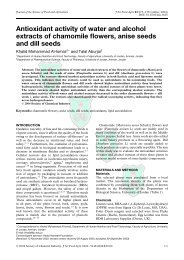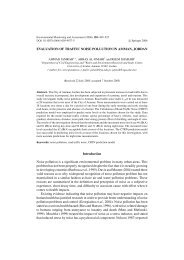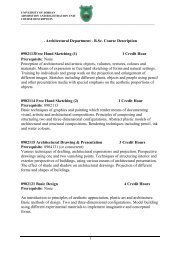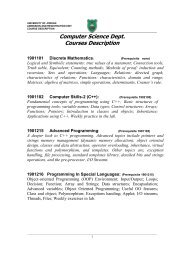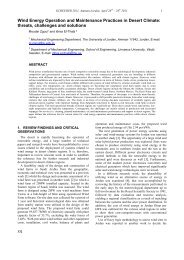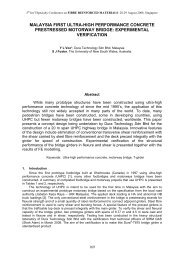(FMEA) in Pharmaceutical Tabletting Tools - The University of Jordan
(FMEA) in Pharmaceutical Tabletting Tools - The University of Jordan
(FMEA) in Pharmaceutical Tabletting Tools - The University of Jordan
You also want an ePaper? Increase the reach of your titles
YUMPU automatically turns print PDFs into web optimized ePapers that Google loves.
Ord<strong>in</strong>al Logistic Regression Model <strong>of</strong> Failure Mode and Effects Analysis<br />
(<strong>FMEA</strong>) <strong>in</strong> <strong>Pharmaceutical</strong> Tablett<strong>in</strong>g <strong>Tools</strong><br />
Mohammad D. AL-Tahat ⇑ , Abdul Kareem M. Abdul Jawwad, Yousef L. Abu Nahleh<br />
<strong>University</strong> <strong>of</strong> <strong>Jordan</strong>, Faculty <strong>of</strong> Eng<strong>in</strong>eer<strong>in</strong>g and Technology, Industrial Eng<strong>in</strong>eer<strong>in</strong>g Department, Amman 11942, <strong>Jordan</strong><br />
article <strong>in</strong>fo<br />
Article history:<br />
Received 1 December 2011<br />
Accepted 16 August 2012<br />
Available onl<strong>in</strong>e 17 September 2012<br />
Keywords:<br />
<strong>Pharmaceutical</strong> Tablett<strong>in</strong>g <strong>Tools</strong><br />
<strong>FMEA</strong><br />
Ord<strong>in</strong>al Logistic Regression (OLR)<br />
1. Introduction<br />
abstract<br />
<strong>The</strong> ma<strong>in</strong> objective <strong>of</strong> this paper is to use Ord<strong>in</strong>al Logistic Regression Model<strong>in</strong>g (OLRM) to<br />
predict and to <strong>in</strong>vestigate the relationship(s) between the different types <strong>of</strong> failures<br />
encountered <strong>in</strong> tablet<strong>in</strong>g tools <strong>of</strong> pharmaceutical <strong>in</strong>dustry and relevant tablet- and punch<br />
attributes. This would help m<strong>in</strong>imize the occurrence <strong>of</strong> such failures <strong>in</strong> and avoid potential<br />
failure occurrences <strong>in</strong> future punch designs. Three punch attributes (punch diameter, location<br />
and shape) and five product attributes (tablet mass (gm), hardness (Kp), thickness<br />
(mm), moisture content (percent loss on dry<strong>in</strong>g (LOD %)) and sieve size (mm)) have been<br />
<strong>in</strong>vestigated <strong>in</strong> terms <strong>of</strong> their relative contributions towards different failure types. <strong>The</strong><br />
present OLRM model has been successfully applied to the predict failure types accord<strong>in</strong>g<br />
to the aforementioned factors. Furthermore, OLRM quantitatively l<strong>in</strong>ks and evaluates the<br />
effects and contribution <strong>of</strong> each <strong>of</strong> these factors to the occurrence <strong>of</strong> different failure types.<br />
<strong>The</strong> OLRM methodology has been validated conveniently and proved to be powerful prediction<br />
tool. This is <strong>in</strong>dicated by the marg<strong>in</strong>al 2.4% error percentage encountered.<br />
Ó 2012 Elsevier Ltd. All rights reserved.<br />
In pharmaceutical <strong>in</strong>dustries, tablets are usually prepared by the <strong>in</strong>stantaneous compression <strong>of</strong> powders between a twopunch<br />
set <strong>in</strong> a cyl<strong>in</strong>drical die Fig. 1. <strong>The</strong> compression force may be supplied by either the lower or upper punch. Tablets are<br />
becom<strong>in</strong>g complex and exotic <strong>in</strong> both shape and pr<strong>of</strong>ile for brand identity market<strong>in</strong>g. As the tablets become more complex so<br />
does the tool<strong>in</strong>g. <strong>The</strong>refore, tool<strong>in</strong>g strength and durability is a major consideration when design<strong>in</strong>g a tablet.<br />
<strong>The</strong> complex design and function <strong>of</strong> tablet<strong>in</strong>g allows a limited number <strong>of</strong> tool materials; particularly steel, to be used for<br />
this purpose among the many steels available. Compaction <strong>of</strong> granules <strong>in</strong>to a solid form (tablet), with sufficient hardness and<br />
bond strength, results <strong>in</strong> high forces on the tool<strong>in</strong>g, not just static load<strong>in</strong>g but cyclic load<strong>in</strong>g <strong>in</strong>flict<strong>in</strong>g both stresses and<br />
stra<strong>in</strong>s. <strong>Pharmaceutical</strong> tablett<strong>in</strong>g tools fac<strong>in</strong>g various types <strong>of</strong> tool breakage/failure; these <strong>in</strong>clude punch-tip breakage/chipp<strong>in</strong>g,<br />
tip wear, punch distortion and shorter punch-lengths among others.<br />
In this research, it is wanted to <strong>in</strong>vestigate the types <strong>of</strong> failures encountered <strong>in</strong> pharmaceutical tablett<strong>in</strong>g punch sets and<br />
what root causes are <strong>in</strong>volved <strong>in</strong> these failures us<strong>in</strong>g Failure Mode and Effects Analysis (<strong>FMEA</strong>). This is expected to help <strong>in</strong><br />
choos<strong>in</strong>g the right tool material, tablet pr<strong>of</strong>iles as well as appropriate operat<strong>in</strong>g and ma<strong>in</strong>tenance procedures to reduce and/<br />
or elim<strong>in</strong>ate punch failures.<br />
<strong>Pharmaceutical</strong> tablets are solid, flat or biconvex dishes prepared by compress<strong>in</strong>g a drugs or a mixture <strong>of</strong> drugs, with or<br />
without diluents. <strong>The</strong>y vary <strong>in</strong> shape and differ greatly <strong>in</strong> size and weight, depend<strong>in</strong>g on the amount <strong>of</strong> medic<strong>in</strong>al substances<br />
and the <strong>in</strong>tended mode <strong>of</strong> adm<strong>in</strong>istration. It is the most popular dosage form account<strong>in</strong>g for 70% <strong>of</strong> the total produced med-<br />
⇑ Correspond<strong>in</strong>g author.<br />
E-mail address: altahat@ju.edu.jo (M.D. AL-Tahat).<br />
1350-6307/$ - see front matter Ó 2012 Elsevier Ltd. All rights reserved.<br />
http://dx.doi.org/10.1016/j.engfailanal.2012.08.017<br />
Eng<strong>in</strong>eer<strong>in</strong>g Failure Analysis 27 (2013) 322–332<br />
Contents lists available at SciVerse ScienceDirect<br />
Eng<strong>in</strong>eer<strong>in</strong>g Failure Analysis<br />
journal homepage: www.elsevier.com/locate/engfailanal
icaments. All medicaments are available <strong>in</strong> the tablet form except where it is difficult to formulate [1]. A tablet should have;<br />
elegant product identity while free <strong>of</strong> defects like chips, cracks, discoloration, and contam<strong>in</strong>ation, sufficient strength to withstand<br />
mechanical shock dur<strong>in</strong>g its production packag<strong>in</strong>g, shipp<strong>in</strong>g and dispens<strong>in</strong>g, chemical and physical stability to ma<strong>in</strong>ta<strong>in</strong><br />
its physical attributes over time, the ability to release medic<strong>in</strong>al agents <strong>in</strong> a predictable and reproducible manner, and<br />
f<strong>in</strong>ally should have a chemical stability over time so as not to allow alteration <strong>of</strong> the medic<strong>in</strong>al agents [1].<br />
Typical production sequence <strong>of</strong> medical tablets, Fig. 2, <strong>in</strong>cludes a fill<strong>in</strong>g stage, a compression stage and ejection stage. In<br />
the fill<strong>in</strong>g stage the exact measurement is used to give accurate weight and dosage for the tablet while fill<strong>in</strong>g the bore <strong>of</strong> the<br />
die with granules.<br />
Compress<strong>in</strong>g <strong>of</strong> granule is essential to provide the correct hardness and solidarity <strong>of</strong> the tablets. If a tablet is not compressed<br />
properly it can crumble. Normally a pre-compression is used prior to the ma<strong>in</strong> compression stage, the purpose <strong>of</strong><br />
which is to remove excess air before the powder is fully compressed and the correct f<strong>in</strong>al pressure is reached. After compression<br />
an ejection mechanism lifts both lower and upper punches and ejects tablets <strong>in</strong>to a collection tray and the entire cycle is<br />
repeated for each tablet.<br />
2. Types and geometries <strong>of</strong> tablett<strong>in</strong>g tools<br />
As po<strong>in</strong>ted to above, two punches are normally employed; an upper punch component to put the pressure on the powder<br />
and to control penetration depth <strong>in</strong>to the die and a lower punch which components for die overfill and achieve f<strong>in</strong>al tablet<br />
weight, Fig. 3, [3]. <strong>The</strong> most important dimension <strong>of</strong> the tool<strong>in</strong>g is the work<strong>in</strong>g length with<strong>in</strong> a set <strong>of</strong> punches. Work<strong>in</strong>g<br />
length, Fig. 3, is normally subject to very tight dimensional control (0.002–0.005 <strong>in</strong>.) [3]. Variations <strong>in</strong> this specification will<br />
result <strong>in</strong> weight, thickness and hardness variation.<br />
Different punch shapes depend on types <strong>of</strong> tablets as shown <strong>in</strong> Fig. 4. Punch shapes can be classified <strong>in</strong>to: Round, Capsuleshape,<br />
oval, geometric (such as square, rectangular and triangular) and irregular shape punch which are used produce tablets<br />
with different shapes like fruits, animals, vehicles etc.<br />
A proper tablet-shape selection is a key requirement for extended punch and die life. This, <strong>of</strong> course, has a great economical<br />
implications on the whole pharmaceutical sector.<br />
Dies are basically hollow cyl<strong>in</strong>drical parts, as shown <strong>in</strong> Fig. 5, with<strong>in</strong> which the compression <strong>of</strong> powder between upper<br />
and lower punches takes place. Good tablet design is essential to prevent downstream production problems, consequently<br />
produc<strong>in</strong>g high quality tablets with maximum efficiency <strong>of</strong> the tablet<strong>in</strong>g process.<br />
3. Failure Mode and Effects Analysis (<strong>FMEA</strong>)<br />
M.D. AL-Tahat et al. / Eng<strong>in</strong>eer<strong>in</strong>g Failure Analysis 27 (2013) 322–332 323<br />
Fig. 1. A schematic illustration <strong>of</strong> a tablet<strong>in</strong>g compression station [2].<br />
Fig. 2. A schematic illustration <strong>of</strong> typical production sequence <strong>of</strong> medical tablets; fill<strong>in</strong>g, compression and then ejection stage [2].<br />
<strong>FMEA</strong> is a procedure that is performed to classify each potential failure effect accord<strong>in</strong>g to its severity and probability <strong>of</strong><br />
occurrence. It is a systematic, proactive method for evaluat<strong>in</strong>g a process to identify where and how a part might fail and to<br />
assess the relative impact <strong>of</strong> different failures, <strong>in</strong> order to identify the parts <strong>of</strong> the process that are most <strong>in</strong> need <strong>of</strong> change.<br />
Several research efforts had been undertaken for the analysis <strong>of</strong> defects <strong>in</strong> manufactur<strong>in</strong>g tools by many approaches but<br />
ma<strong>in</strong>ly us<strong>in</strong>g <strong>FMEA</strong> [4].<br />
In an attempt to <strong>in</strong>crease die-set life, Alpagut et al. [5] <strong>in</strong>vestigated the possible use <strong>of</strong> Zirconia as a material for the manufacture<br />
<strong>of</strong> punches and dies for use <strong>in</strong> tablet<strong>in</strong>g mach<strong>in</strong>es and its effect on ejection <strong>of</strong> tablets. An experimental study to
324 M.D. AL-Tahat et al. / Eng<strong>in</strong>eer<strong>in</strong>g Failure Analysis 27 (2013) 322–332<br />
Fig. 3. Upper punch and lower punch components [3].<br />
Fig. 4. Round shape punch die sets and Capsule shape [2].<br />
Fig. 5. Die geometry and shape (I Holland) [2].<br />
<strong>in</strong>vestigate the movement <strong>of</strong> powder dur<strong>in</strong>g the axially symmetrical uni-axial compaction <strong>of</strong> microcrystall<strong>in</strong>e cellulose has<br />
been carried out by Brunel et al. [6], they concluded that chang<strong>in</strong>g the geometry <strong>of</strong> the punch and die set would <strong>in</strong>herently
change the direction <strong>of</strong> the resultant forces caus<strong>in</strong>g major changes <strong>in</strong> the direction <strong>of</strong> powder movement and thus, response<br />
to wear and other failure mechanisms.<br />
Dubar et al. [7] proposed a new approach to the degradation <strong>of</strong> cold forg<strong>in</strong>g tool<strong>in</strong>g, where a tablett<strong>in</strong>g die is analogous to<br />
forg<strong>in</strong>g tools with powder flow replaced metal flow <strong>in</strong> their model<strong>in</strong>g. <strong>The</strong> approach is developed depend<strong>in</strong>g on samples<br />
com<strong>in</strong>g from actual work pieces, and contactors com<strong>in</strong>g from actual tools at various stages <strong>of</strong> their lifetime. A study made<br />
by Kanga et al. [8] on a die wear model consider<strong>in</strong>g thermal s<strong>of</strong>ten<strong>in</strong>g <strong>in</strong>volved the construction <strong>of</strong> the wear model <strong>in</strong> order to<br />
predict tool life by wear based on the general Archard’s wear model. In Archard’s model, the hardness <strong>of</strong> a die is usually considered<br />
to be a function <strong>of</strong> both temperature and the operat<strong>in</strong>g time <strong>of</strong> the die. A study on die stress analysis <strong>of</strong> the orbital<br />
forg<strong>in</strong>g process to obta<strong>in</strong> die stress distributions and predict die failures had been made by Sheu and Yu [9], the different<br />
<strong>in</strong>stallation positions <strong>of</strong> punches, performs, and pr<strong>of</strong>iles <strong>of</strong> punch tip and tool configurations were proposed to imply the type<br />
<strong>of</strong> die failure conditions. <strong>The</strong> results <strong>of</strong> Sheu and Yu [9] showed that <strong>in</strong>stallation errors and punch tip with long mandrel and<br />
split die configurations would result <strong>in</strong> significant die stresses with the correspond<strong>in</strong>g die failures.<br />
Despite the widespread use <strong>of</strong> such tool<strong>in</strong>g worldwide, and their versatile consequent failures, this subject has been dealt<br />
with ma<strong>in</strong>ly <strong>in</strong> <strong>in</strong>dustrial pathways and has grasped very limited attention with<strong>in</strong> the academic and research communities.<br />
This has created a vital need for a systematic research program <strong>in</strong> order to tackle the different types <strong>of</strong> failures encountered<br />
<strong>in</strong> these tools. Given the immense global production volume <strong>of</strong> tablett<strong>in</strong>g tools, it has been envisaged that a quantitative<br />
treatment <strong>of</strong> failure evaluation would be more beneficial to this subject than a ‘‘simply’’ basic qualitative failure mode analysis.<br />
This has shaped the ma<strong>in</strong> theme <strong>of</strong> the present paper.<br />
In this paper <strong>FMEA</strong> will be applied to <strong>in</strong>vestigate at the ma<strong>in</strong> types <strong>of</strong> failures <strong>in</strong> the punch set and what are the root<br />
causes for these failures. OLR model<strong>in</strong>g has been used to quantitatively l<strong>in</strong>k and evaluate the effect and contribution <strong>of</strong><br />
the aforementioned factors to the occurrence <strong>of</strong> the different failure types.<br />
4. Qualitative analysis <strong>of</strong> collected data<br />
M.D. AL-Tahat et al. / Eng<strong>in</strong>eer<strong>in</strong>g Failure Analysis 27 (2013) 322–332 325<br />
<strong>The</strong> data used <strong>in</strong> the current research has been provided by a major <strong>Jordan</strong>ian pharmaceutical producer cover<strong>in</strong>g production<br />
period 2007–2009 and account<strong>in</strong>g for a total <strong>of</strong> 381 punches. Three major types <strong>of</strong> failures have been found common <strong>in</strong><br />
these punches (i) concentricity failures (punch distortion lead<strong>in</strong>g to <strong>of</strong>f center position<strong>in</strong>g), (ii) edge failures (either a cracked<br />
or chipped edge) and (iii) length variation (shorten<strong>in</strong>g <strong>of</strong> punch length). <strong>The</strong>se failures are denoted C, E and L, respectively,<br />
Table 1. In addition to the ma<strong>in</strong> ‘‘s<strong>in</strong>gle’’ failure modes, various punches have been found to suffer from a comb<strong>in</strong>ation <strong>of</strong> two<br />
or three <strong>of</strong> the above failure types, Table 1, lead<strong>in</strong>g to a total <strong>of</strong> six failure modes. For model<strong>in</strong>g purposes the different six<br />
failure modes are assigned ‘‘codes’’ between 0 and 5, Table 1. A cause-and-effect analysis <strong>of</strong> the tablett<strong>in</strong>g process, conducted<br />
dur<strong>in</strong>g this research, has led to three fishbone diagrams, Figs. 6–8, mapp<strong>in</strong>g the ma<strong>in</strong> failure modes (C, E and L, respectively)<br />
to their probable causes and/or contribut<strong>in</strong>g factors.<br />
Frequencies <strong>of</strong> occurrence for each type <strong>of</strong> failure accord<strong>in</strong>g to punch shape and position are shown <strong>in</strong> Table 2. It could be<br />
seen that edge failures and length variation are more frequent <strong>in</strong> the lower punches than <strong>in</strong> the upper punches. About 70% <strong>of</strong><br />
concentricity failures are seen to have taken place <strong>in</strong> the upper punches. Concave punches have the highest frequency <strong>of</strong> failures.<br />
Similarly failure types were also related to punch shape and diameter as shown <strong>in</strong> Table 3 and Table 4 respectively. <strong>The</strong><br />
8.4 mm diameter punch is seen to have the highest frequency (80%) <strong>of</strong> these failures.<br />
Generally the most frequent defect <strong>of</strong> tablet<strong>in</strong>g tools is edge breakage. Edge breakage may happen as a result <strong>of</strong> two<br />
mechanisms dur<strong>in</strong>g the compression stage <strong>of</strong> the tablett<strong>in</strong>g process; (i) an excessive pressure <strong>in</strong> order to compensate for<br />
a shorter punch length; or (ii) a sudden impact force due to an eccentric punch (presence <strong>of</strong> type-C failure). Type-C failure,<br />
itself, could have been, also, caused by an excessive pressure lead<strong>in</strong>g to punch distortion. It could be concluded at this po<strong>in</strong>t<br />
that edge breakage (type-E failure) is usually preceded by one or both <strong>of</strong> the other two failure types (L and C). Type-C failure<br />
would, most probably, be preceded by type-L failure, which seems to be the first <strong>in</strong> failure sequence.<br />
Edge breakage problem is more frequent <strong>in</strong> the lower punches than <strong>in</strong> the upper punches. This could be directly l<strong>in</strong>ked to<br />
the higher frequency <strong>of</strong> length variation <strong>in</strong> the lower punch. <strong>The</strong> lower punch is more likely to experience more wear dur<strong>in</strong>g<br />
the tablet<strong>in</strong>g process. This comes from the fact that there are less low punches than upper punches as well as the fact that a<br />
major portion <strong>of</strong> the pressure is experienced by the lower punch. For example <strong>in</strong> the concave 8.4 mm size, there are 13 upper<br />
punches versus 3 lower punches only. Accord<strong>in</strong>gly, the lower punches are likely to experience more concentricity failures. It<br />
is noted, however, that 70% <strong>of</strong> this failure take place <strong>in</strong> the upper punch. This is due to the fact that the upper punch moves<br />
Table 1<br />
Classification <strong>of</strong> types <strong>of</strong> found failures.<br />
Seq. Failure Code<br />
1 Concentricity (C) 1<br />
2 Edge (E) 2<br />
3 Length variation (L) 3<br />
4 Comb<strong>in</strong>ed failure (L) + (E) + (C) 5<br />
5 Comb<strong>in</strong>ed failure (L) + (C) 4<br />
6 Comb<strong>in</strong>ed failure (C) + (E) 0
326 M.D. AL-Tahat et al. / Eng<strong>in</strong>eer<strong>in</strong>g Failure Analysis 27 (2013) 322–332<br />
Fig. 6. Fishbone diagram for concentricity (C) failure.<br />
Fig. 7. Fishbone diagram for edge (E) failure.<br />
up outside the die and down <strong>in</strong>side the die, hence would not have the support from the die like the lower punch which stays<br />
<strong>in</strong>side the die dur<strong>in</strong>g the whole production cycle. This is expected to <strong>in</strong>crease the chance <strong>of</strong> concentricity failures <strong>in</strong> the upper<br />
punch. <strong>The</strong> concave shape has the highest frequency <strong>of</strong> failures that are present (72%). This is due to the fact that this shape<br />
has the highest production level and the smallest punch sizes lead<strong>in</strong>g to more pressure concentration.
Table 2<br />
Distribution <strong>of</strong> failures accord<strong>in</strong>g to punch shape and position.<br />
Among the comb<strong>in</strong>ed failures it could be seen that the present <strong>in</strong>tersections (<strong>in</strong>stances <strong>of</strong> mutual presence) are<br />
{(L) + (E) + (C)}, {(L) + (C)}, and {(C) + (E)} but no <strong>in</strong>tersection between {(L) + (E)}. This implies a complete absence <strong>of</strong> the comb<strong>in</strong>ed<br />
failures {(L) + (E)}. Based on this, edge breakage failure seem to be a f<strong>in</strong>al occurrence and there would be two routes<br />
lead<strong>in</strong>g this failure; either after both length variation and concentricity through excessive force (as expla<strong>in</strong>ed above) or after<br />
concentricity due to sudden impact load<strong>in</strong>g. This also <strong>in</strong>dicates that the length variation problems are not always detected by<br />
the <strong>in</strong>spection workers.<br />
5. Failure prediction us<strong>in</strong>g Logistic Regression Model<strong>in</strong>g<br />
M.D. AL-Tahat et al. / Eng<strong>in</strong>eer<strong>in</strong>g Failure Analysis 27 (2013) 322–332 327<br />
Fig. 8. Fishbone diagram for length variation (L) failure.<br />
Punch Frequencies <strong>of</strong> occurrence <strong>of</strong> failure type Total<br />
Type Shape Code Concentricity (C) Length variation (L) Edge (E) (C) + (E) (L) + (C) (C) + (E) + (L)<br />
Upper punches Oval 10 36 2 38<br />
Oblong 9 7 8 15<br />
Flat 8 2 2<br />
Concave 7 54 1 39 36 130<br />
Sub-total 63 37 47 36 2 0<br />
Lower punches Oval 6 9 7 16<br />
Oblong 5 11 11<br />
Flat 4 2 12 14<br />
Diamond 3 5 5<br />
Concave 2 11 40 72 25 148<br />
Caps 1 2 2<br />
Sub-total 26 54 79 0 12 25<br />
Total 89 91 126 36 14 25 381<br />
Logistic Regression Analysis (LRA) extends the techniques <strong>of</strong> Multiple Regression Analysis (MRA) to research situations <strong>in</strong><br />
which the outcome variable is categorical rather than a variable with a numerical value [10]; the fundamental model underly<strong>in</strong>g<br />
MRA posits that a cont<strong>in</strong>uous outcome variable is a l<strong>in</strong>ear comb<strong>in</strong>ation <strong>of</strong> a set <strong>of</strong> predictors and error. Thus, for an<br />
outcome variable, Y, and a set <strong>of</strong> C predictor variables, X1,...,Xp, the MRA model is <strong>of</strong> the form [11]:
328 M.D. AL-Tahat et al. / Eng<strong>in</strong>eer<strong>in</strong>g Failure Analysis 27 (2013) 322–332<br />
Table 3<br />
Distribution <strong>of</strong> failure accord<strong>in</strong>g to tool diameter.<br />
Punch diameter (mm) Frequencies <strong>of</strong> occurrence <strong>of</strong> failure type Total<br />
Concentricity (C) Length variation (L) Edge (E) (C) + (E) (L) + (C) (C) + (E) + (L)<br />
11.11 6 36 25 67<br />
11.3 ⁄ 8.25 5 5<br />
12.7 4 12 16<br />
18.5 ⁄ 10.25 7 2 9<br />
5 ⁄ 10 2 1 3<br />
5.5 ⁄ 8 44 44<br />
6 ⁄ 15 2 2<br />
6.35 40 36 76<br />
7 ⁄ 18.25 16 8 24<br />
8.4 11 1 75 87<br />
8 8 8<br />
10.3 40 40<br />
Y ¼ a þ b1X1 þ b2X2 þ þbpXp þ e ¼ a þ X<br />
bjXj þ e ð1Þ<br />
j¼1<br />
where b j is a multiple (partial) regression coefficient and e is the error <strong>of</strong> prediction. If the error is omitted, the result<strong>in</strong>g model<br />
represents the expected, or predicted, value <strong>of</strong> Y [11]:<br />
eðYjX1; ...; XpÞ ¼Y 0 ¼ a þ Xp<br />
j¼1<br />
b jXj<br />
Each observed score, Y, is made up <strong>of</strong> a predictable, component, Y 0 , that is a function <strong>of</strong> the predictor variables X1,...,Xp,<br />
and an error, or unpredictable component, e, that represents error <strong>of</strong> measurement and/or error <strong>in</strong> the selection <strong>of</strong> the model<br />
[12].<br />
<strong>The</strong> model for LRA assumes that the outcome variable, Y, is categorical. For simplicity, and because it is the most case<br />
commonly encountered <strong>in</strong> practice, it is assumed that Y is dichotomous, tak<strong>in</strong>g on values <strong>of</strong> 1 and 0. Information <strong>in</strong> Fig. 9<br />
represents M<strong>in</strong>itab output for Ord<strong>in</strong>al Logistic Regression Model (OLRM) employed <strong>in</strong> this study.<br />
6. Results and discussion <strong>of</strong> OLRM<br />
Table 4<br />
Samples punch specifications.<br />
Specification Failure code<br />
1 2 3<br />
Diameter (mm) 15.5 12.75 7.5<br />
Location 2 1 2<br />
Mass (mg) 900 710 123<br />
Hardness (Kp) 18 24 3.5<br />
Thickness (mm) 6.4 5.5 3.45<br />
Moisture (LOD %) 2.7 3 1<br />
Sieve (mm) 1 1 1<br />
OLRM described <strong>in</strong> Fig. 9 shows the estimates <strong>of</strong> the b coefficients, their standard deviations, z-values and p-values. <strong>The</strong><br />
odds ratio and 95% confidence <strong>in</strong>tervals for each <strong>of</strong> the coefficients are also shown. All variables with p value less than 0.05<br />
are significant <strong>in</strong> the model. Log Likelihood (LL) expla<strong>in</strong>s the probability <strong>of</strong> the observed results given the b coefficients. S<strong>in</strong>ce<br />
the likelihood is always less than 1 it is customary to use the logarithm <strong>of</strong> the likelihood multiplied by 2. This value provides<br />
a measure <strong>of</strong> how well the model fits the data. <strong>The</strong> LL statistic is analogous to the error sum <strong>of</strong> squares <strong>in</strong> multiple<br />
l<strong>in</strong>ear regressions. As such it is an <strong>in</strong>dicator <strong>of</strong> how much unexpla<strong>in</strong>ed <strong>in</strong>formation rema<strong>in</strong>s after fitt<strong>in</strong>g the model. A large<br />
value means a poorly fitt<strong>in</strong>g model and vice versa. <strong>The</strong>refore, a reliable model would have a small LL value (and hence, a<br />
small 2LL value). If a model fits perfectly, the LL value would be is 1 lead<strong>in</strong>g to a 2LL value <strong>of</strong> zero ( 2 log 1 = 0).<br />
One advantage <strong>of</strong> multiply<strong>in</strong>g the log likelihood by 2 is that 2LL has an approximately chi-square distribution mak<strong>in</strong>g it<br />
possible to compare values aga<strong>in</strong>st those that arise by chance alone. <strong>The</strong> present observed LL value is 30.661, Fig. 9, <strong>in</strong>dicat<strong>in</strong>g<br />
a satisfactory model<strong>in</strong>g and fitt<strong>in</strong>g data. Significant p value at the bottom <strong>of</strong> the regression table <strong>in</strong>dicates that there is<br />
a significant association between at least one explanatory variable and the outcome by test<strong>in</strong>g whether all slopes are equal to<br />
zero. If the p value were not significant there would be no need to go further.<br />
ð2Þ
M.D. AL-Tahat et al. / Eng<strong>in</strong>eer<strong>in</strong>g Failure Analysis 27 (2013) 322–332 329<br />
Fig. 9. M<strong>in</strong>itab output <strong>of</strong> the proposed OLRM.<br />
<strong>The</strong> p values for each term <strong>in</strong> the model <strong>in</strong>dicate whether or not there is statistically significant association between a<br />
particular explanatory variable and the outcome. Goodness-<strong>of</strong>-fit tests are usually general tests that assess the fitted model’s<br />
overall departure from the observed data [13], Two classical global goodness <strong>of</strong> fit tests for the OLRM have been adapted; the<br />
Pearson test and the residual deviance test [14], which compare the fit <strong>of</strong> the model with the saturated model.
330 M.D. AL-Tahat et al. / Eng<strong>in</strong>eer<strong>in</strong>g Failure Analysis 27 (2013) 322–332<br />
Table 5<br />
Results <strong>of</strong> apply<strong>in</strong>g the OLRM on three samples.<br />
Sample number Constant number<br />
a1 a2 a3 a4 a5 1 42.2346 14.0315 2.93722 34.33702 46.46002<br />
2 30.3187 2.11562 14.85309 46.25288 58.37589<br />
3 72.6083 44.4052 27.4365 3.963309 16.08631<br />
<strong>The</strong>se two are available for most <strong>of</strong> the OLRM(s) for categorical responses. <strong>The</strong>se measures can be directly obta<strong>in</strong>ed from<br />
most <strong>of</strong> the established statistical packages. However under the null hypothesis <strong>of</strong> a well fitted model, the distributions <strong>of</strong><br />
the goodness <strong>of</strong> fit statistics are approximately chi-square distributed only if most expected counts formed by the cross classification<br />
<strong>of</strong> the response levels and all covariates are greater than 5 [15]. <strong>The</strong> goodness <strong>of</strong> fit hypothesis is;<br />
H 0: <strong>The</strong> model fits well to the data.<br />
H1: <strong>The</strong> model does not fit well to the data.<br />
As shown <strong>in</strong> Fig. 9, p-values <strong>of</strong> the two tests are greater than 0.05 <strong>in</strong>dicat<strong>in</strong>g that the model satisfies the goodness <strong>of</strong> fit at<br />
5% significant level, the null hypothesis will not be rejected. It should be noted here that, contrary to the case <strong>of</strong> normal l<strong>in</strong>ear<br />
regression, a p value larger than the confidence level is needed for model significance.<br />
Fig. 9 displays also the numbers and percent <strong>of</strong> concordant, discordant and tied pairs, as well as the common correlation<br />
tests. Large values for Somer’s D, Goodman–Kruskal–Gamma and Kendall’s Tau – <strong>in</strong>dicate that the model has a good predictive<br />
ability. In our case there were 99.2% pairs concordant and 0.7% discordant giv<strong>in</strong>g 99% better chance for pairs to be concordant<br />
than discordant, <strong>in</strong>dicat<strong>in</strong>g the model to have excellent predictive ability.<br />
7. Model validation<br />
While there are six different responses (failure modes), the OLRM <strong>in</strong> Fig. 9 shows that there are five constants only. This<br />
comes from the fact that for G outcome categories, there is only one parameter (b) for each <strong>of</strong> the predictor variables (e.g., b1<br />
for predictor X 1). However, there is still a separate <strong>in</strong>tercept term (a g) for each <strong>of</strong> the G–1 comparisons mak<strong>in</strong>g the number <strong>of</strong><br />
constants equal to the number <strong>of</strong> response-1 [16]. <strong>The</strong> shaded box <strong>in</strong> Fig. 9 shows Logistic Regression parameters. At this<br />
stage the present model is ready to be tested and evaluated us<strong>in</strong>g punch specifications given <strong>in</strong> Table 4 and the observed<br />
failure types. Comparison between prediction results and actual failures would <strong>in</strong>dicate the predictive power <strong>of</strong> the model.<br />
Fig. 10. Rotat<strong>in</strong>g-head type punch [2].
OLRM validation has been implemented as follows:<br />
One <strong>of</strong> the five constants (g values) is chosen for further calculations with its correspond<strong>in</strong>g a, i.e., when g =1a1 will be<br />
used, when g =2a 2 will be used and so on. After the constant has been computed, the model will be applied as follow:<br />
Y ¼ a þ 18:8983ðDiameterÞ 15:042ðLocationÞ 0:3381ðMassÞþ1:78037ðHardnessÞþ32:7696ðThicknessÞ<br />
þ 11:4021ðMoistureÞ 317:81ðSieveÞ ð3Þ<br />
Table 5 shows the results <strong>of</strong> apply<strong>in</strong>g this model for the three sample specifications<br />
<strong>The</strong> Barrel <strong>of</strong> the punch did not experience any type <strong>of</strong> failure, the failure occurs on the tip and the head <strong>of</strong> the punch so<br />
the design can be more flexible by us<strong>in</strong>g ‘‘<strong>in</strong>sert-type’’ tips and heads, <strong>in</strong> which case these will be changed when ever failure<br />
occurs. <strong>The</strong> number <strong>of</strong> upper punches is more than lower punches result<strong>in</strong>g <strong>in</strong> larger production volumes per punch for lower<br />
sets. A future design may then look <strong>in</strong>to more balance life cycles <strong>of</strong> upper and lower punches. As the first type <strong>of</strong> failure to<br />
occur is length variation, and as this is ma<strong>in</strong>ly due to wear <strong>of</strong> punch head, it would be beneficial to use a more wear-resistant<br />
material for this part <strong>of</strong> the punch.<br />
8. Conclud<strong>in</strong>g remarks<br />
In this research study Failure Mode and Effects Analysis (<strong>FMEA</strong>) has been applied to relate ma<strong>in</strong> types <strong>of</strong> failure that occur<br />
<strong>in</strong> pharmaceutical punch sets to their root causes both qualitatively and quantitatively (through OLR model<strong>in</strong>g). Types <strong>of</strong><br />
failures experienced <strong>in</strong> tablet<strong>in</strong>g punches have been revealed to be affected by; punch diameter, punch location, punch<br />
shape, product mass, product hardness, product thickness, moisture content and product sieve size. Edge-breakage problems<br />
were found to account for 33% <strong>of</strong> failures; followed by length variation (23.9%) and then concentricity (23.4%). <strong>The</strong> most logical<br />
failure sequence which seems to fit the data presented <strong>in</strong> this study seems to start with length variation followed by<br />
concentricity and f<strong>in</strong>ally edge breakage/chipp<strong>in</strong>g. An OLR model has been obta<strong>in</strong>ed and was successfully applied for the prediction<br />
<strong>of</strong> potential failure type(s) based on punch and product attributes.<br />
<strong>The</strong> OLRM is validated conveniently; it proved to be powerful prediction tool with m<strong>in</strong>or percentage error value <strong>of</strong> 2.4%.<br />
9. Recommendations<br />
Given the failure sequence postulated <strong>in</strong> this study, i.e., failure cycle stars with a shorten<strong>in</strong>g <strong>in</strong> the punch length, and the<br />
fact that expected failure commencement sites are only at the tip (through breakage/chipp<strong>in</strong>g) and punch head (through<br />
wear) with the rest <strong>of</strong> the punch body (barrel) be<strong>in</strong>g unaffected, a viable means <strong>of</strong> avoid<strong>in</strong>g whole-punch replacement is<br />
to utilize replaceable (<strong>in</strong>sert-type) punch-head and tip <strong>in</strong> future designs. A rotat<strong>in</strong>g punch-head would also be a viable option<br />
to m<strong>in</strong>imize the amount <strong>of</strong> wear encountered, Fig. 10. In future work, chemical composition <strong>of</strong> the tablets may be considered<br />
as an <strong>in</strong>put variable to <strong>in</strong>vestigate its effect on the different types <strong>of</strong> failures occurr<strong>in</strong>g <strong>in</strong> pharmaceutical punch sets.<br />
Acknowledgment<br />
This work is extracted from a master’s thesis entitled ‘‘Failure Mode and Effects Analysis (<strong>FMEA</strong>) <strong>in</strong> <strong>The</strong> <strong>Pharmaceutical</strong><br />
Tablet<strong>in</strong>g <strong>Tools</strong>’’ which has been successfully defended, approved, and published by <strong>The</strong> <strong>University</strong> <strong>of</strong> <strong>Jordan</strong> <strong>in</strong> July 2010. It<br />
was supervised by Dr. Mohammad D. Al-Tahat and Dr. Abdul Kareem M. Abdul Jawwad, and was prepared by graduate student<br />
Yousef Lutfi A. Abu Nahleh, to whom this work primarily belongs.<br />
References<br />
M.D. AL-Tahat et al. / Eng<strong>in</strong>eer<strong>in</strong>g Failure Analysis 27 (2013) 322–332 331<br />
[1] Sahoo PK. <strong>Pharmaceutical</strong> technology tablets. Delhi Institute <strong>of</strong> <strong>Pharmaceutical</strong> Sciences and Research, Pusph Vihar-III, M.B. Road, New Delhi 110 017;<br />
2007.<br />
[2] I Holland Troubleshoot<strong>in</strong>g <strong>in</strong> Tablet Tool<strong>in</strong>g Sem<strong>in</strong>ar, I Holland Limited Meadow Lane, Long Eaton, Nott<strong>in</strong>gham. NG10 2GD, England; 2010.<br />
[3] Techceuticals. A tablet mak<strong>in</strong>g tra<strong>in</strong><strong>in</strong>g resource for tablet mak<strong>in</strong>g pr<strong>of</strong>essionals, 365 Red Cedar Street, Suite 202 Bluffton, South Carol<strong>in</strong>a, USA 29910–<br />
4519; 2011. .<br />
[4] William W<strong>in</strong>chell. Cont<strong>in</strong>uous quality improvement: a manufactur<strong>in</strong>g pr<strong>of</strong>essional’s guide. society <strong>of</strong> manufactur<strong>in</strong>g eng<strong>in</strong>eers, Product ID: BK91PUB3<br />
ISBN: 978-087263405; 1991.<br />
[5] Alpagut K, Michael JT, Ron S. An application for zirconia as a pharmaceutical die set. J Eur Ceram Soc 2003;24(10–11):3091–101.<br />
[6] Eiliazadeh Brunel, Pitt Kendal, Briscoe Brian. Effects <strong>of</strong> punch geometry on powder movement dur<strong>in</strong>g pharmaceutical tablet<strong>in</strong>g processes. Int J Solids<br />
Struct 2004;41(21):5967–77.<br />
[7] Dubar M, Dubar L, Dubois A. Wear analysis <strong>of</strong> tools <strong>in</strong> cold forg<strong>in</strong>g: PVD versus CVD TiN coat<strong>in</strong>gs. Wear 2005;259(1–2):1109–16.<br />
[8] Kanga JH et al. A study on a die wear model consider<strong>in</strong>g thermal s<strong>of</strong>ten<strong>in</strong>g: (I) construction <strong>of</strong> the wear model. J Mater Process Technol<br />
1998;96(1999):53–8.<br />
[9] Sheu JJ, Yu CH. <strong>The</strong> die failure prediction and prevention <strong>of</strong> the orbital forg<strong>in</strong>g process. J Mater Process Technol 2008;20(1):9–13.<br />
[10] Peng Chao-Y<strong>in</strong>g Joanne, Lee Kuk-Lida, Gary M. An <strong>in</strong>troduction to logistic regression analysis and report<strong>in</strong>g. J Educ Res 2002;96(1):3–14.<br />
[11] Gude Just<strong>in</strong> A, Mitchell Michael S, Ausband David E, Sime Carolyn A, Bangs Edward E. Internal validation <strong>of</strong> predictive logistic regression models for<br />
decision-mak<strong>in</strong>g <strong>in</strong> wildlife management. Wildlife Biol 2009;15:352–69.<br />
[12] Xian-J<strong>in</strong> X, Jane P, William C. Increas<strong>in</strong>g the power: a practical approach to goodness-<strong>of</strong>-fit test for logistic regression models with cont<strong>in</strong>uous<br />
predictors. Comput Stat Data Anal 2008;52:2703–13.<br />
[13] Archer Kellie J, Lemeshow Stanley. Goodness-<strong>of</strong>-fit test for a logistic regression model fitted us<strong>in</strong>g survey sample data. Stata J 2006;6(1):97–105.
332 M.D. AL-Tahat et al. / Eng<strong>in</strong>eer<strong>in</strong>g Failure Analysis 27 (2013) 322–332<br />
[14] Kuss Oliver. Global Global Goodness-<strong>of</strong>-Fit Tests <strong>in</strong> Logistic Regression with Sparse Data. Institute <strong>of</strong> Medical Epidemiology: Biostatistics and<br />
Informatics, Medical Faculty <strong>University</strong> <strong>of</strong> Halle-Wittenberg; 2002.<br />
[15] Abeysekera W, Sooriyarachchi R. A novel method for test<strong>in</strong>g goodness <strong>of</strong> fit <strong>of</strong> a proportional odds model: an application to an AIDS study. J Nat Sci<br />
Found Sri Lanka 2008;36(2):125–35.<br />
[16] David GK, Mitchel K. Logistic regression: a self-learn<strong>in</strong>g text. 2nd ed. Spr<strong>in</strong>ger; 2002.


